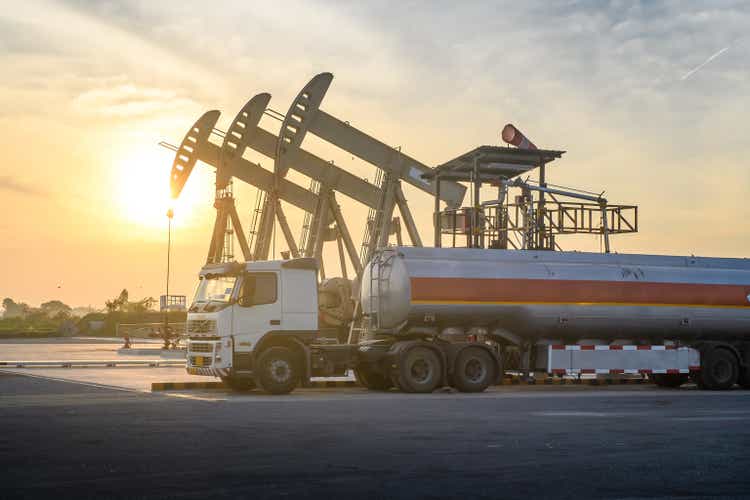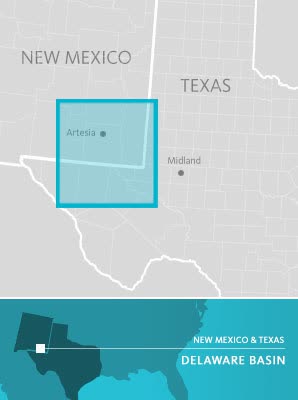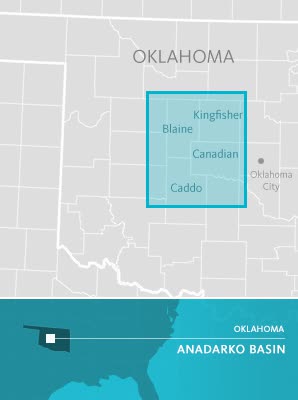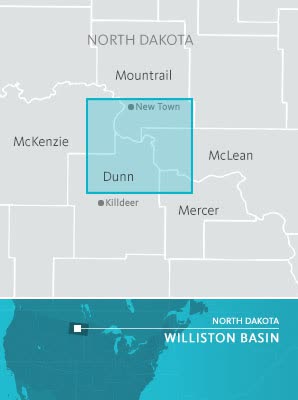Devon Energy: A Discussion On Their Recession Resistance

Summary
- Devon Energy Corporation boasts low breakeven WTI prices of $45/bbl for the base dividend and $40 for self-funding.
- A look at the basins in which Devon Energy Corporation operates reveals some weakness, but much more in strength.
- Overall, Devon Energy Corporation appears quite recession resistant, with an examination of their upstream production assets.
Otakeja/iStock via Getty Images
Recessionary Impacts
In this article, we'll look at Devon Energy Corporation's (NYSE:DVN) positioning in the upstream industry, and how their breakeven pricing - and the basin's breakeven pricing as a whole - contributes to their ability to withstand a recession.
It's no secret that many investors are concerned about a recession, and dividend investors want to make sure those dividends keep flowing. In upstream-focused companies, the major thing we want to look at is where their breakeven pricing is for WTI and Henry Hub.
By examining Devon Energy Corporation's breakeven pricing, both from materials the company presents, as well as external sources about basin average breakeven pricing, we can extrapolate a decent prediction as to a producer's ability to withstand a recession. They do provide a decent amount of projections in their investor presentations - but we always want to do our best as investors to verify the veracity of such claims.
Please note that DVN has significant midstream holdings that can further provide revenues and synergistic vertical integration, but we're going to focus on their upstream assets in this article. Many other authors here on Seeking Alpha have written fantastic reviews of the entire company as a whole, so we're just going to focus on one part of them.
For thoughts on the potential impact of a recession on oil pricing, please read this previous article I wrote, as I'll reference it here in this one.
Company Overview
Devon Energy is one of the largest oil & gas companies in the United States and is what folks in the industry refer to as "one of the majors." Devon is a leading independent oil and natural gas exploration and production company. Upstream operations for Devon are focused in five core areas - Delaware Basin, Eagle Ford, Anadarko Basin, Powder River Basin, and the Williston Basin.
Operations
The company is vertically integrated with entire divisions dedicated to midstream & marketing functions to complement its impressive production division. Devon's midstream function is responsible for constructing and operating pipelines, storage and treating facilities, and compression and gas processing plants.
The marketing function of the company is responsible for the sale of its oil, gas, and natural gas liquids (NGLs). The marketing division not only helps with the sale of products like ethane, propane, butane, and natural gasoline, but employees are also responsible for transportation, storage, processing, and treating.
Now, let's take a look at their production areas.
Delaware Basin
Area of operations in Delaware Basin (Devon Energy)
Company operations across southeast New Mexico and west Texas provide both oil and natural gas production across the Delaware Basin. The company has a core acreage position consisting of approximately 400,000 net acres across multiple formations. Drilling activity in this region yields outstanding well productivity and drives growth for the company.
Breakeven pricing for the Delaware Basin is typically the lowest of any major shale play at approximately $46/bbl and with a large net acreage position, the company is in a fantastic position for future and controlled growth.
This play makes up the bulk of the company's production at 64.7% as of Q1-2023. The margins aren't as good as Eagle Ford or Power River, but they're much better than their Anadarko holdings. As of Q1, their field level cash margin was $35.71/Boe.
It's interesting that their margins are so low here compared to other low cost basins. This may be related to the large amount of Gas and NGL they produce here, or perhaps legacy contracts causing higher production costs, but they do not provide a breakdown for individual products, only Boe. This won't be a problem though, unless we see oil fall well below $60/bbl for a sustained period of time.
Right now they're full speed ahead with CapEx in this basin reaching $584M for Q1, and 16 rigs currently drilling. Clearly, even with the low field-level cash margin, the company believes it can continue to drill and produce effectively in the Delaware. They touched on this a tad in the conference call (emphasis added):
Matthew Portillo:
Just to start out, as we look across the portfolio, it's nice to have a diversified asset. Curious, as you guys look at the returns by basin and with the volatility in the commodity strip, how you're thinking about capital allocation to some of the basins like the ANADARKO in particular, given low natural gas and NGL prices as well as some downside volatility to crude oil as we progress through the year?
Clay Gaspar:
Hey Matt, this is Clay. Great question, in the last 12 months, we've kind of tested every flavor of commodity price. High oil price, low oil price, high relative gas price, 10:1, it was $80 and $8 at one point. And so we've run the sophisticated model that we have in a number of scenarios really looking for when does our portfolio really command that we shift the capital allocation materially?
And what was interesting is, in all of those scenarios that we ran even some of the gas-levered opportunities, it still said keep pushing towards oil, keep pushing towards the Permian, the Delaware Basin. We're still always commanding capital first. As we've matured our understanding of places like the Eagle Ford, certainly, it's risen up. And with the acquisition of Validus, it's commanding more capital, as I mentioned earlier.
It looks like they have the situation well thought out, and their strong presence in the basin is likely to contribute to their success. Without access to more detailed pricing information regarding their oil operations in the basin, it's difficult to say for certain at which price their operations would be affected here, but they seem to think it's not a problem.
| Type | Oil (MBbls/d) | Oil Equiv (MBoe/d) |
| Gross | 211 | 415 |
| % of Total Production | 65.9% | 64.7% |
Source: Devon Energy
Anadarko Basin
Area of operations in Anadarko Basin (Devon Energy)
Devon's Anadarko Basin activity is located primarily in Oklahoma, with one of the largest positions in the industry in this shale play. The company's contiguous acreage footprint is primarily located in the over-pressured oil window. They focus specifically on the Meramec and Cana-Woodford Shale.
This shale play is typically the highest-average breakeven pricing (approx. $66/bbl) compared to any of the other major shale plays in the U.S., and Devon's margins reflect that fact.
Their field-level cash margin comes in at only $21.09/Boe, making this the lowest margin play for the company. In the event of a recession, I'd expect drilling to be curbed immediately in this area. Thankfully it only makes up 12.6% of the company's output.
| Type | Oil (MBbls/d) | Oil Equiv (MBoe/d) |
| Gross | 15 | 81 |
| % of Total Production | 4.6% | 12.6% |
Source: Devon Energy
Eagle Ford
Area of operations in Eagle Ford Basin (Devon Energy)
Production in the Eagle Ford region has low-cost access to premium gulf coast pricing, providing very solid operating margins for most companies in the region and Devon is no different.
The company is seeing outstanding well results that are offering some of the high rate-of-return drilling opportunities in North America. With breakeven pricing in the Eagle Ford estimated to be around $59/bbl for most companies, investors can see that DVN is doing something right as it is producing exemplary returns on some of the best light oil in the world in the Eagle Ford.
Despite the typical high break even, Devon is finding a fantastic field-level cash margin of $41.75! Despite having only 82,000 acres they're pouring CapEx into the basin with $192M last year, second only to the Delaware.
They're finding great success maximizing that lower acreage with consistent successful high infill spacing of 16-24 wells per section. They're also refracing wells with hundreds of potential candidates. They're doing everything right in Eagle Ford, and it would be fantastic to see them acquire more rights here.
| Type | Oil (MBbls/d) | Oil Equiv (MBoe/d) |
| Gross | 40 | 68 |
| % of Total Production | 12.5% | 10.6% |
Source: Devon Energy
Williston Basin
Area of operations in Williston Basin (Devon Energy)
Devon's Williston Basin position consists of 123,000 net acres where operations are focused in the Bakken and Three Forks formations, two of the most prolific shale plays in the U.S.
Breakeven pricing in this region averages around $60/bbl. And crude oil pricing floors, even in the face of recession, should at least maintain current production levels. When you factor in the administration's commitment to refilling the SPR, it seems like a floor of $65/bbl is likely.
Right now their field-level cash margin is $32.65/Boe, making it the second-worst margin following Anadarko. In the event of a recession, drilling would likely be curbed in favor of other locations, both due to low cash margins and the fact they have very few company resources focused here with a CapEx of only $99M in Q1.
| Type | Oil (MBbls/d) | Oil Equiv (MBoe/d) |
| Gross | 36 | 53 |
| % of Total Production | 11.2% | 8.2% |
Source: Devon Energy
Powder River Basin
Area of operations in Power River Basin (Devon Energy)
The Powder River Basin is located in southeast Montana and northeast Wyoming. Devon's Rocky Mountain operations are focused on oil opportunities in this region.
A few pockets of the area account for most of the production success as breakeven pricing in this region can vary from $48/bbl to $70/bbl. Their field-level cash margin is $41.43, making this play very profitable for the company. It's unfortunate they don't have a larger position here. They're expanding slowly in the area though, with $38M in CapEx expended here in Q1.
In the event of a recession, given their good margins in the area, drilling and production would likely continue.
| Type | Oil (MBbls/d) | Oil Equiv (MBoe/d) |
| Gross | 14 | 19 |
| % of Total Production | 4.3% | 2.9% |
Breakdown
| Basin | Oil Equiv % of Total | Field Level Cash Margin |
| Delaware | 64.7% | $35.71 |
| Anadarko | 12.6% | $21.09 |
| Eagle Ford | 10.6% | $41.75 |
| Williston | 8.2% | $32.65 |
| Powder River | 2.9% | $41.43 |
Clearly, the Anadarko basin is the most at risk due to a recession. If we saw prices fall heavily this one is first on the chopping block for CapEx and production levels.
Williston and Delaware fall in the middle of the pack with a $32 and $35 field-level margin. These can likely stay above water fairly well, especially in Delaware given their extensive presence in the region and midstream integration.
The Eagle Ford and Power River plays are fantastically profitable for the company, and unlikely to have any cuts in the face of recession.
Compared to one of their biggest Delaware Basin competitors (and biggest competitors in general), EOG, they come in pretty decently in terms of expense per Boe. The two companies measure this in different ways, but EOG comes in at ~$11.54 expense off the gross, while DVN hits $12.24 - measured as best I can compare to DVN's method of accounting. These are company-wide numbers for Boe.
Overall, unless we had a very deep recession showing WTI pricing dropping deep into the $50s, I don't really see any issue here for DVN. They have fantastic recession resistance when you look at the costs in their various areas of operation. The company itself measures the base dividend payable down to $45, which seems like it's a fair analysis.
Latest Earnings Call Analysis
Last year was a year for the record books for Devon Energy Corporation. The company achieved all of its capital objectives and delivered the best financial performance in the company's 52-year history, despite world economies still not having completely recovered from the Covid-19 downturn.
Furthermore, Devon celebrated a new company record on returns on capital employed at 39%, which greatly outpaced the S&P 500 (SP500). This strong capital efficiency translated into free cash flow ("FCF") reaching an all-time high of $6 billion in 2022.
Investors certainly should be bullish after the news that Devon is on track in 2023 to deliver a high single-digit growth rate, with capital investment requirements as much as $3.8 billion being self-funded at pricing levels as low as $40/bbl WTI crude oil price.
This demonstrates the operational efficiency of the company and the durability of its business model. Average breakeven funding pricing at $40/bbl has to be among the lowest in the industry, and investors should be excited at the company's strong financial growth. Based on what I've seen with their costs, that $40/bbl rock bottom breakeven is likely correct.
Their latest investor presentation highlighted this company-wide breakeven pricing for WTI, showing that the base dividend would be unaffected down to $45/bbl.
Devon stressed its commitment to shareholders by prioritizing funding dividends and through share buybacks. In fact, the company announced an increase of 11% for fixed dividend payouts beginning in March and Devon also plans to reduce its outstanding share count by 4% through a $2 billion share repurchase program.
This is all made possible by the company's strong free cash flow, operational efficiencies, and attractive core positions in the most profitable shale plays in the United States.
Conclusion
Devon Energy Corporation is one of the majors and does just about everything. The company is vertically integrated with operations focused on five of the most prolific shale plays in North America. The company has a diversified portfolio of hedging instruments that also help to provide flexibility, and this diversity and commitment to a strong balance sheet are among the many reasons that Devon could be argued as the most valuable energy company that investors should be looking at. There is a reason that Devon delivered record financial results in 2022, significantly outpacing peers.
Investors should certainly be bullish on the future of the company, and Devon Energy is a name that should be on your radar. With vertical integration within the oil and gas industry and commitment to operational efficiencies in production, the company is well-positioned for long-term growth.
As a producer, Devon Energy Corporation is certainly vulnerable to commodity price dips in the event of the looming recession. However, a strong balance sheet and operational efficiencies should help shield the company from lasting recession effects, especially compared to company peers.
Overall, when looking at Devon Energy Corporation, its areas of operation, and associated costs of upstream production, I've got to give this one a buy recommendation for the dividend investor. The base dividend isn't going anywhere, and they're going to have the resources to keep that variable dividend coming, probably averaging around 5% or so total through 2023. The Devon Energy Corporation price has fallen significantly from the highs and is very attractive at the moment.
About this article: When I research stocks I start with a "bird's eye view" of the target company. Many of the things I went through in this article are what I'll look at first.
When this bird's eye view is complete, I'll decide if I want to avoid the company for the time being or if it's a potential candidate for investment. This article that you are reading is the result of my bird's eye view examination.
It is designed to be an overall high-level view of the company that you can read to determine if this company is something that you might consider as a candidate for investment. It is not possible to report everything about a company in the space of a single article, nor is it possible for me as an author to learn every detail about a company in the amount of time allotted to write an article.
You should not take my final conclusion on the company as your sole recommendation for investment, and you should conduct further in-depth research on your own to come to your final conclusions.
As a result of this, my "buy" recommendations come with an asterisk. And that asterisk is that this is only a high-level examination, and in-depth research that can take many hours, or days, of your time is still required. This is why my articles are short and to the point, with no fluff or filler. Just the facts that you need to know to move forward.
Sources
This article was written by
Analyst’s Disclosure: I/we have a beneficial long position in the shares of DVN either through stock ownership, options, or other derivatives. I wrote this article myself, and it expresses my own opinions. I am not receiving compensation for it (other than from Seeking Alpha). I have no business relationship with any company whose stock is mentioned in this article.
Seeking Alpha's Disclosure: Past performance is no guarantee of future results. No recommendation or advice is being given as to whether any investment is suitable for a particular investor. Any views or opinions expressed above may not reflect those of Seeking Alpha as a whole. Seeking Alpha is not a licensed securities dealer, broker or US investment adviser or investment bank. Our analysts are third party authors that include both professional investors and individual investors who may not be licensed or certified by any institute or regulatory body.
